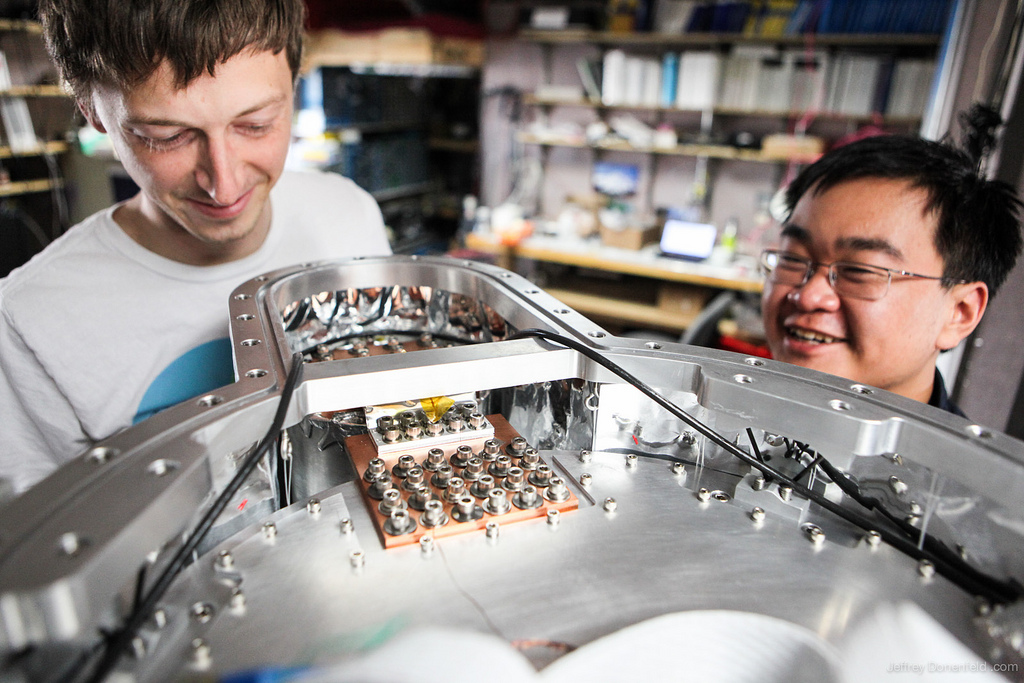This week, I was fortunate to be given unprecedented access to the Keck Array Microwave Telescope in the MAPO Observatory at the Amundsen-Scott South Pole Station by the Keck Array Science Team, in order to witness the disassembly of two of the five cryostats that form the telscope array. Photos.
The Keck array is a microwave telescope, just like Bicep2 and the South Pole Telescope (SPT). However, Keck (or SPUD, as some call it, depending on which side of the funding table the person you’re asking is sitting) is special. Keck, in an effort to up sensitivity and resolution, has taken the best of all worlds, and combined them into one super-telescope. They’ve taken the extremely successful and proven focal plane design from Bicep2, as well as the extremely efficient and self contained pulse-tube cooled cryostat from SPT, and made it into their own super telescope. And then multiplied it by five.
The Keck has not one, but five identical cryostats, each housing its own focal plane. Having five instead of one gives the team an incredible amount of sensing options and flexibility. One distinct advantage that I was able to see up close and personal is that individual parts can be serviced and worked on without bringing the entire telescope to a halt.
More info on the Keck Array:
This past week, the Keck Array science team removed two of the five cryostats, and left three in place and operational.
Here are a few photos of the disassembly of the cryostats, stripping away all of their shielding and refrigeration to get to the heart – the focal plane.
Keck Array is housed in the MAPO Observatory, a 15 minute walk from the Amundsen-Scott South Pole Station. Although it’s only a short ways away, in -40 degree F temperatures, full sunlight, driving wind, and an active ice runway to cross, full gear and extreme caution must be used on the walk across the ice. It feels a bit like walking to class – although much colder. And at one of the most remote spots on the planet. That big plywood cone in the background in the groundshield of the telescope.




Looking straight up inside the telescope, as Scientist Colin Bischoff explains the inner workings.

https://flickr.com/photos/jamfan2/8229064838/in/set-72157632128663490/lightbox/

Before disassembly, the cryostats are inspected for defects or light leaks.


Disassembly begins – very slowly and carefully – each cryostat is custom built and unique, the result of thousands of hours of R&D.




The team mid-project. I even got to help out a bit!


The inner core is revealed. This is the core refrigerator that’s responsible for cooling the focal plane down to an incredible 250 millikelvin. That’s just barely above absolute zero. The refrigerator uses both commonplace Helium-4, as well as exotic Helium-3, which is contained within the smaller titanium pressure vessel in the close-up shot.



And finally, the heart of the beast – the focal plane. These four panels sense polarization of focused microwave radiation using chips filled with TES Bolometers. More info on Bicep2 and Keck’s TES Bolometers from NASA JPL:
Transition edge sensor (TES) bolometers sense small temperature changes that occur when photons are absorbed and converted to heat. The use of TESs enables arrays with a much larger number of pixels than is practical with spider-web bolometers. Sustaining its leading role in superconducting TES array technology, MDL developed and continues to improve a process to create arrays of thousands of TESs with high yield (>90 percent). These arrays are being employed on three major astro physics projects, all with the same goal: generating detailed maps of the polarization of the cosmic microwave background (CMB).


https://flickr.com/photos/jamfan2/8229070600/in/set-72157632128663490/lightbox/



That’s it. Thanks very much to the entire Keck Array Science Team for generously inviting me into their lab.

Comments
2 responses to “Getting To The Heart Of The Keck Array Microwave Telescope: Cryostat Disassembly”
Wow, I love these pictures! Colin’s mom
[…] Working on KECK […]